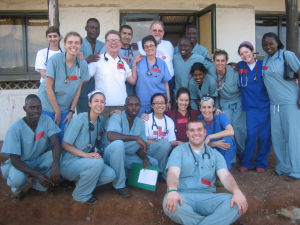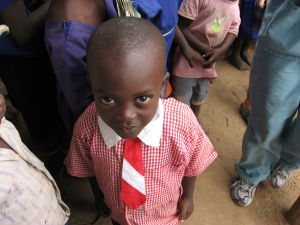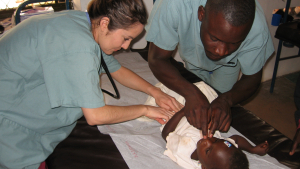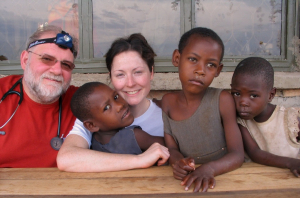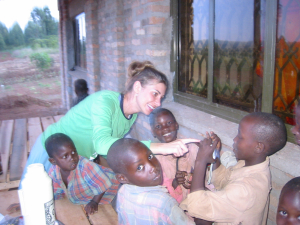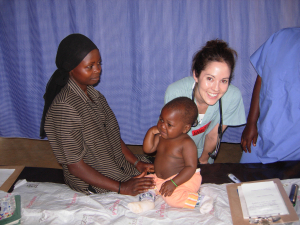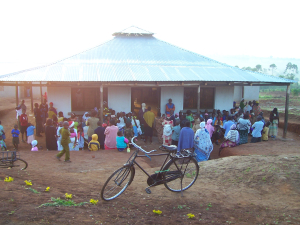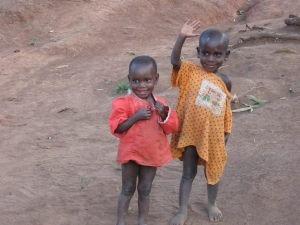Albany Medical Volunteers Open Engeye Health Clinic in Uganda
In partnership with local Ugandans, three medical students have brought sustainable healthcare, for the first time, to a forgotten region of Uganda.
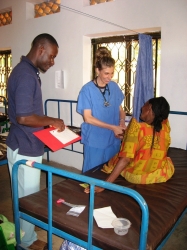
Albany, NY, June 21, 2007 --(PR.com)-- The 2007 spring break for three medical students in the midst of their second year of school was not the typical white sand beach escape designed to offset the rigors of medical school. Instead, after working over the past year with their now clinic manager, John Kalule, a local Ugandan, they headed to rural Uganda with a team of 14 other doctors, students and nurses, and opened the doors of the health clinic they had built earlier that year in Ddegeya Village, Uganda.
In the midst of a forgotten region of Uganda with no electricity, no running water, no transportation and no health care, they brought hope to the villagers. Together with local nurses and translators, they provided medical care to over 750 community members who had never been seen by a health care worker. A nurse was hired to remain on board full-time after their spring break departure, and John Kalule, who leads the entire project in Uganda, is busy continuing upgrades to the site.
The spring 2007 visit marked the beginning of a sustainable healthcare system for the villagers. The next medical mission is scheduled for November 2007. While the primary medical students responsible for the rural health clinic -- Stephanie Van Dyke, Misty Richards and Brooke Richards -- are thrilled with their accomplishments, they realize that there’s much more to be done. Prior to their next trip back, they hope to bring electricity to the clinic and build and stock an on-site laboratory.
Despite the success of Engeye Health Clinic's maiden voyage, they were forced to accommodate an obvious deficiency -- the lack of a diagnostic lab to accurately identify the disease. With no advancements of medicine on hand, such as microscopes or rapid tests, during their spring 2007 Uganda mission, they were forced to make educated guesses based on a patient's visible symptoms and medical history. Malaria, STDs, HIV and TB appeared to be widespread. However, without any previous data, statistics for the region or diagnostic testing, they could not be certain what diseases are plaguing the village and causing so many deaths.
The addition of laboratory tests will facilitate better medical care and treatment. In addition to servicing the needs of Engeye Clinic, the lab will serve as a fund-raising tool because it will enable Engeye Clinic to run tests for other clinics, a luxury currently nonexistent in the region. The group is conscientious with regards to sustainability and is ensuring all their advancements will create a self-sustaining system. Currently, the small amount charged for each patient’s visit is enough to fund the purchase of new medications. The team has started both construction of the laboratory and wiring of the Engeye Clinic for electricity, and is confident that they will be completed prior to their next mission in November 2007. In 2008, they plan to add a trauma wing and dental and eye care units.
The villagers are thrilled and support the project whole-heartedly. They feel proud to have their village hosting the clinic and have shown their thanks in many ways, including festive singing and dancing. Many have commented that they’ve been asking for the angels to help them, and finally they have heard their calling. The U.S. medical students and Ugandan staff have a unique bond -- two worlds uniting, listening to each other and respecting each other’s differences, all in attempt to raise the standard of living in a region where it is currently unacceptable. They are a small group of Americans and Ugandans, working to improve the living conditions and reduce the unnecessary suffering in rural Africa through education and health care.
The entire clinic and two volunteer houses were constructed during the summer of 2006 at an estimated cost of $50,000 by The Engeye Health Clinic’s founder, Stephanie Van Dyke, her parents, Gary Arnold, who led the construction efforts and is the father of a fellow classmate, several other volunteers and at least 50 villagers. An inheritance from her grandmother was Stephanie’s gift to the project and her parents helped supply the remainder needed. Upon returning to the States after building the clinic, Misty Richards and Brooke Richards, two fellow medical students, joined in the efforts and the three comprise the board of directors for the non-profit organization.
Stephanie met and befriended John Kalule, the primary Ugandan partner leading the project, while volunteering in Uganda in 2000. The word Engeye means "white monkey" in Luganda, an official language of the country, and is John's family clan name. The team realizes their responsibility. They understand the fact, and do not take it lightly, that whatever they do, or don't do, will directly influence the villager's well-being. Everybody realizes that without good health, the villagers will never begin to overcome the poverty of their country.
The official Mission Statement of the Engeye Health Clinic is: “To improve living conditions and reduce unnecessary suffering in rural Africa through education and compassionate health care. Implicit to every project that we undertake is the understanding that it will ultimately be sustainable with little or no outside assistance, and that it will be accomplished free of the imposition of any foreign social, political, or spiritual values.”
The spring 2007 medical mission comprised of second year Albany Medical College students, Kim Robinson, Misty Richards, Evan Rodriguez, Stephanie Van Dyke, Brooke Richards, Lalithapriya Jayakumar, Julie Huynh and Jackie Schwartz, fourth year student Zoe Selhi and Sarah Levasseur, RN, Cynthia Hartman, Seth Edwards, a pre-medical student from St. Rose College, and two physicians, Dr. Bob Paeglow and Dr. Joe Murley. Dr. Paeglow, of Albany Medical College, was profiled in People Magazine in 2006 for his charity work and community involvement. To learn more, please visit Engeye Health Clinic at www.engeye.com. Engeye, Inc. is a 501(c)(3) tax deductible, non-profit organization.
###
In the midst of a forgotten region of Uganda with no electricity, no running water, no transportation and no health care, they brought hope to the villagers. Together with local nurses and translators, they provided medical care to over 750 community members who had never been seen by a health care worker. A nurse was hired to remain on board full-time after their spring break departure, and John Kalule, who leads the entire project in Uganda, is busy continuing upgrades to the site.
The spring 2007 visit marked the beginning of a sustainable healthcare system for the villagers. The next medical mission is scheduled for November 2007. While the primary medical students responsible for the rural health clinic -- Stephanie Van Dyke, Misty Richards and Brooke Richards -- are thrilled with their accomplishments, they realize that there’s much more to be done. Prior to their next trip back, they hope to bring electricity to the clinic and build and stock an on-site laboratory.
Despite the success of Engeye Health Clinic's maiden voyage, they were forced to accommodate an obvious deficiency -- the lack of a diagnostic lab to accurately identify the disease. With no advancements of medicine on hand, such as microscopes or rapid tests, during their spring 2007 Uganda mission, they were forced to make educated guesses based on a patient's visible symptoms and medical history. Malaria, STDs, HIV and TB appeared to be widespread. However, without any previous data, statistics for the region or diagnostic testing, they could not be certain what diseases are plaguing the village and causing so many deaths.
The addition of laboratory tests will facilitate better medical care and treatment. In addition to servicing the needs of Engeye Clinic, the lab will serve as a fund-raising tool because it will enable Engeye Clinic to run tests for other clinics, a luxury currently nonexistent in the region. The group is conscientious with regards to sustainability and is ensuring all their advancements will create a self-sustaining system. Currently, the small amount charged for each patient’s visit is enough to fund the purchase of new medications. The team has started both construction of the laboratory and wiring of the Engeye Clinic for electricity, and is confident that they will be completed prior to their next mission in November 2007. In 2008, they plan to add a trauma wing and dental and eye care units.
The villagers are thrilled and support the project whole-heartedly. They feel proud to have their village hosting the clinic and have shown their thanks in many ways, including festive singing and dancing. Many have commented that they’ve been asking for the angels to help them, and finally they have heard their calling. The U.S. medical students and Ugandan staff have a unique bond -- two worlds uniting, listening to each other and respecting each other’s differences, all in attempt to raise the standard of living in a region where it is currently unacceptable. They are a small group of Americans and Ugandans, working to improve the living conditions and reduce the unnecessary suffering in rural Africa through education and health care.
The entire clinic and two volunteer houses were constructed during the summer of 2006 at an estimated cost of $50,000 by The Engeye Health Clinic’s founder, Stephanie Van Dyke, her parents, Gary Arnold, who led the construction efforts and is the father of a fellow classmate, several other volunteers and at least 50 villagers. An inheritance from her grandmother was Stephanie’s gift to the project and her parents helped supply the remainder needed. Upon returning to the States after building the clinic, Misty Richards and Brooke Richards, two fellow medical students, joined in the efforts and the three comprise the board of directors for the non-profit organization.
Stephanie met and befriended John Kalule, the primary Ugandan partner leading the project, while volunteering in Uganda in 2000. The word Engeye means "white monkey" in Luganda, an official language of the country, and is John's family clan name. The team realizes their responsibility. They understand the fact, and do not take it lightly, that whatever they do, or don't do, will directly influence the villager's well-being. Everybody realizes that without good health, the villagers will never begin to overcome the poverty of their country.
The official Mission Statement of the Engeye Health Clinic is: “To improve living conditions and reduce unnecessary suffering in rural Africa through education and compassionate health care. Implicit to every project that we undertake is the understanding that it will ultimately be sustainable with little or no outside assistance, and that it will be accomplished free of the imposition of any foreign social, political, or spiritual values.”
The spring 2007 medical mission comprised of second year Albany Medical College students, Kim Robinson, Misty Richards, Evan Rodriguez, Stephanie Van Dyke, Brooke Richards, Lalithapriya Jayakumar, Julie Huynh and Jackie Schwartz, fourth year student Zoe Selhi and Sarah Levasseur, RN, Cynthia Hartman, Seth Edwards, a pre-medical student from St. Rose College, and two physicians, Dr. Bob Paeglow and Dr. Joe Murley. Dr. Paeglow, of Albany Medical College, was profiled in People Magazine in 2006 for his charity work and community involvement. To learn more, please visit Engeye Health Clinic at www.engeye.com. Engeye, Inc. is a 501(c)(3) tax deductible, non-profit organization.
###
Contact
Heising Communications
Dawna Lee Heising
714-390-7122
www.engeye.com
Dawna Lee Heising
714-390-7122
www.engeye.com
Multimedia
Categories

